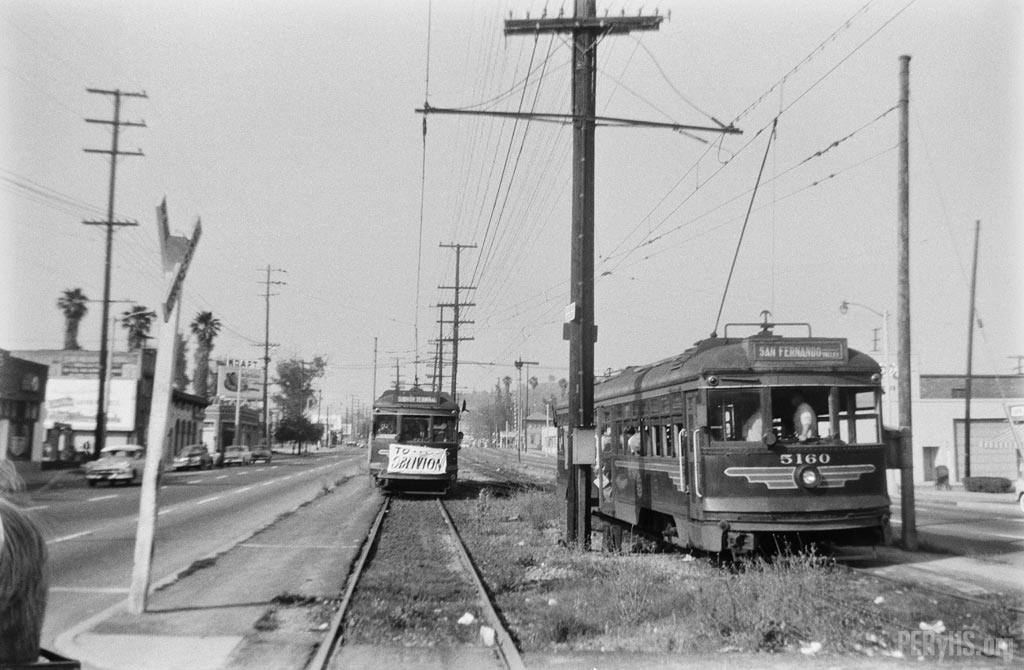To Oblivion (Past 5160)
Metropolitan Coach Lines (ex-Pacific Electric) cars roll down the Glendale-Burbank Line on Brand and Glendale Blvd., just south of the Southern Pacific tracks, in this image probably from the late 1950s. The unidentified car has a “To Oblivion” banner draped across its nose, as was common with fan trips on soon-to-be-abandoned routes. No. 5160 waits on an adjacent track.
Bill Whyte Photo, Steve Crise Collection
Recent Posts
Showing 11 comments



The year would be 1955 as service was discontinued in June of that year. The location is Glendale Blvd in what is now called Atwater Village.
These two pictures took some effort. If the date is correct, and this wasn’t a branch of a 1954 fan trip to Santa Monica or something, getting two 5050s to Glendale would have taken some doing. By mid 1955, the only place 5050s were in service was LA to Watts. To get them to Glendale would have taken a trip from 6th & Main to Amoco, a right turn at Oscar’s Junction and a trip out the Santa Monica Airline to Talamantes. Another right turn, and a couple of miles North up next to the West side of Sepulveda Blvd, another right turn, then East on the remaining part of the Santa Monica line that was still in freight service.
At Glendale Blvd, they could either have changed ends and gone to Glendale, or continued on to the Subway Terminal, and then changed ends and gone to Glendale.
I don’t doubt that routing these cars onto the Glendale/Burbank line took some effort, but the Subway was used for filming shortly after service was discontinued on the Glendale/Burbank line and these cars could have been the ones that were set aside for that film. It’s possible that both cars were on Railfan excursions after the cessation of regular service.
The Glendale-Burbank line had 5050’s right to the end of service. There were no special movements to get the cars to the Subway but I believe around eight were removed by truck after abandonment. Some were repainted solid red for the filming of “While The City Sleeps” before their removal from the now closed Subway Terminal.
That’s around La Clede Ave and Glendale Blvd. You can see Glendale Tower between the semaphore and the 5160. I’d guess it was one of the fan trips the day after regular service ended June 18-19, 1955. I grew up, and was living there then, at 1836 Gardena Ave, the street with the tall palm trees behind the tower. The SP tracks at the tower were the boundry between LA and Glendale. On the Glendale side, Glendale Blvd becomes Brand Blvd.
Alan Miller
Santiago, Chile
I think Alan’s story about his Rhodesian train adventure is perhaps his best and most interesting.
The 2 cars in this photo are #5160 chartered by the SC-ERA and #5164 chartered by the PRS. The photo was taken on June 19,1955, the day the line was abandoned. These were the only 2 cars on the line that BLACK DAY IN SOUTHERN CALIF. The abandonment of the Glendale – Burbank line was a travesty! The PE had spent millions of dollars in early 1940 to bring the track and overhead up to PERFECT condition in preperation of the arrival of the new PCC’s. The infrastructure of the line still had 40 years life remaining. WHAT A WASTE.
I can not read the name of the line or destination on the train with the Too Oblivion sign. Do you think that it would have read Glendale-Burbank ? or was it on its way to Los Angeles?
– it says “Subway Terminal” – ed.
Historically, near the TROPICO area! Or what once was that town. The ESPEE-PERy exchange yard would have been to the left on the west side of the SP main. The palm trees extending up toward the SP Glendale Station (ex-Tropico station site) are a reconizable feature in film and photos. You’ll see them in a few Highway Patrol episodes shot around the station. Though it became forgotten after the absorption into greater Glendale, Tropico was a destination served by PE and not just another way stop on the Glendale-Burbank Line. As it turns out, Huntington co-hort /engineer/manager Epes Randolph (SP, PE, LARy and more) was listed as a board member of the 1906 incorporated California Tile and Terra Cotta Company which took over the 1900- tile works. (Western Art Tile, c.1904?, had offices in the Main Street Terminal.) Later Pacific Tile and Terra Cotta, Tropico Pottery, Gladding-McBean Company, and finally known as Franciscan China. Naturally, there must have been a PE role that has not been fully explored. [Tile works/Pottery plants west side of tracks just up at what became Loz Feliz, and streets of Tropico town on east side of tracks.] The clay sources were reportedly out beyond Corona. (Perhaps the Alberhill finds?) Santa Fe originating territory on Elsinore line, and SP access lines to the plants, but maybe PE was a routing for material or finished products if anyone knows?
Later found Harrington pit near Alberhill supplied the Tropico works but was closed and under control of Alberhill company. Also, some raw materials were kept in supply in Santa Monica at one of the brick plants to be transferred from there to Tropico by an un-named routing.
Scrolling down left side to a small photo of Daylight train boarding passengers at Glendale, a PERY passenger car is viewed on extreme left somewhere near the end of the exchange yard line: https://spdaylight.net/Service.html
Anybody got information on any known through PE passenger service right to (just opposite) the Tropico or Glendale SP Stations?